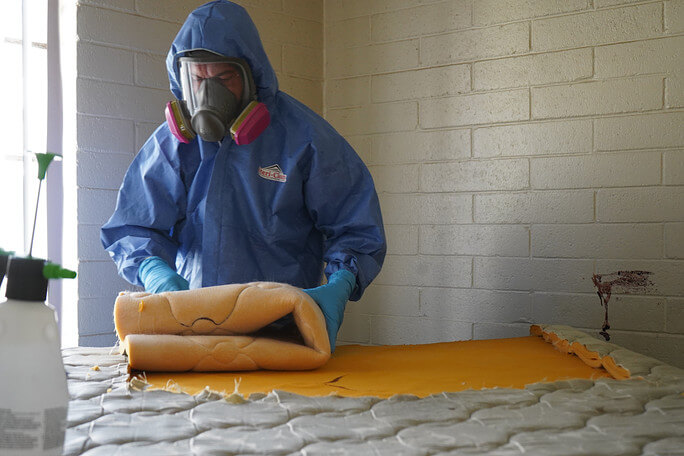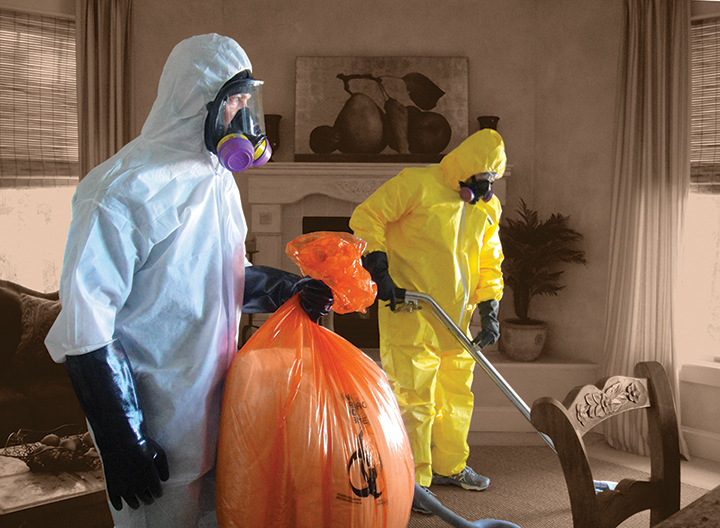Precise ATP Testing for Effective Sanitation and Hygiene Monitoring
Precise ATP Testing for Effective Sanitation and Hygiene Monitoring
Blog Article
Expert Biohazard Cleaning and Purification for Blood, Bodily Fluids, and Hazardous Materials
The potential wellness risks connected with exposure to biohazards underscore the essential requirement for precise handling and thorough cleaning. As we browse the elaborate landscape of biohazard clean-up, understanding the nuances of guidelines, compliance, and the specialized devices at play becomes vital in making certain a thorough and secure decontamination process.
Health And Wellness Threats of Biohazard Exposure
Exposure to biohazards poses considerable health and wellness dangers that can result in serious repercussions for people and areas alike. Biohazards include a wide variety of organic substances, consisting of blood, physical liquids, mold, bacteria, infections, and other potentially transmittable products. When individuals come right into call with these biohazards, whether via crashes, improper handling, or environmental exposure, they face the risk of having severe ailments or conditions.
Among the primary wellness threats related to biohazard exposure is the transmission of infectious illness. Bloodborne pathogens such as HIV, liver disease B and C, and various microorganisms can be existing in biohazardous products, positioning a direct danger to human health and wellness. Breathing in airborne biohazards like mold and mildew spores or entering into contact with infected surface areas can likewise result in breathing concerns, allergies, and other negative health impacts.
Additionally, biohazard exposure can have long-term wellness implications, with some conditions materializing years after the preliminary call (Blood Cleanup). Therefore, it is vital to focus on correct biohazard cleaning and purification to reduce these health and wellness risks and guarantee the safety of areas and individuals

Specialized Educating for Biohazard Cleaning
When it comes to managing biohazard clean-up efficiently and safely, specialized training plays a fundamental role in making sure proper decontamination procedures are complied with. Biohazard cleanup requires particular expertise and skills to effectively alleviate dangers connected with bloodborne pathogens, physical fluids, and dangerous materials. Professionals educated in biohazard cleanup undertake rigorous guideline on just how to securely deal with, eliminate, and take care of biohazardous materials to stop contamination and direct exposure.
Specialized training for biohazard cleanup covers an array of crucial subjects, consisting of appropriate personal safety tools (PPE) use, bloodborne virus understanding, purification strategies, and contaminated materials disposal protocols. People educated in biohazard cleaning are geared up with the required competence to assess contamination degrees, recognize potential hazards, and implement appropriate clean-up procedures in compliance with regulatory criteria.
Continuous training and education and learning are critical in the field of biohazard cleanup to remain upgraded on the newest purification technologies, security methods, and laws. By buying specialized training, biohazard clean-up professionals can properly react to emergency situation cleanup scenarios and secure both public health and the setting.
Relevance of Correct Decontamination Strategies
Utilizing proper decontamination strategies is vital in biohazard cleaning to successfully get rid of hazardous materials and reduce wellness dangers. Efficient decontamination not only makes certain the elimination of noticeable traces of blood, physical liquids, and various other biohazards yet likewise targets unseen virus that may position serious health and wellness threats if not appropriately gotten rid of. you could look here By adhering to rigid purification protocols, educated professionals can considerably lower the risk of direct exposure to hazardous bacteria, infections, and bacteria that might bring about diseases or infections.
Proper purification strategies entail the use of specialized devices and anti-bacterials that are specifically designed to reduce the effects of biohazards efficiently. Detailed cleansing and disinfection of contaminated areas are vital to protect against the spread of pathogens and guarantee a secure atmosphere for occupants. In addition, the correct disposal of biohazardous waste following purification treatments is essential in preventing contamination of various other surface areas or people.

Tools and Tools for Safe Clean-up
When dealing with blood, bodily fluids, or hazardous products, biohazard cleaning experts count on specialized equipment to lessen exposure threats and completely sanitize the damaged area. Additionally, biohazard cleaning packages containing disinfectants, absorptive products, and biohazard bags are used to securely contain and get rid of of infected things.
Advanced cleaning tools like hospital-grade anti-bacterials, HEPA-filtered vacuum cleaners, and misting devices are employed to sanitize surfaces and get rid of biohazards properly. Specialized devices such as sharps containers and biohazard garbage disposal containers are utilized to securely manage sharp things and biohazardous waste products. By making use of the ideal devices and devices, biohazard cleaning professionals can ensure a complete cleaning procedure that prioritizes safety and lessens health risks for both workers and occupants of the damaged space.
Laws and Compliance in Biohazard Cleansing
Proper adherence to guidelines and conformity criteria is critical in biohazard cleansing to make sure the security of both workers and the atmosphere. Federal government agencies such as OSHA (Occupational Safety and Health Administration) and the EPA (Epa) have actually developed specific guidelines for biohazard cleaning procedures to minimize wellness threats and ecological contamination. These regulations cover a series of elements including the handling, transportation, and disposal of biohazardous products, in addition to the required training and safety tools required for workers entailed in the cleaning process.
Biohazard cleansing business must remain current with these laws read what he said to guarantee that their procedures meet the required security criteria. Failing to adhere to these laws can result in serious effects, including penalties, lawsuit, and endangering the health of people and the setting. By adhering to strict guidelines and compliance measures, biohazard cleaning companies can effectively mitigate risks and guarantee a safe and comprehensive cleaning procedure for all events included.
Conclusion
In verdict, biohazard cleansing and decontamination call for customized training, appropriate techniques, and adherence to laws. Exposure to blood, physical fluids, and dangerous products poses considerable wellness risks, making it critical to use the ideal tools and tools for risk-free cleaning. By following strict procedures and standards, specialists can efficiently alleviate the threats associated with biohazard exposure and make sure the safety and security of both themselves and others.
As we navigate the elaborate his comment is here landscape of biohazard clean-up, recognizing the subtleties of regulations, conformity, and the customized tools at play becomes imperative in guaranteeing a secure and comprehensive purification procedure. (Blood Cleanup)
When it comes to handling biohazard cleanup effectively and securely, specialized training plays a basic role in guaranteeing appropriate purification procedures are followed.Utilizing appropriate purification strategies is crucial in biohazard clean-up to efficiently get rid of harmful materials and reduce health and wellness dangers. Additionally, biohazard cleaning packages including disinfectants, absorbent materials, and biohazard bags are used to safely include and get rid of of contaminated items.
Government agencies such as OSHA (Occupational Safety And Security and Health And Wellness Administration) and the EPA (Environmental Protection Firm) have actually established specific standards for biohazard clean-up procedures to decrease health and wellness risks and ecological contamination.
Report this page